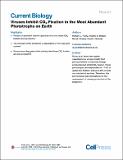Files in this item
Viruses inhibit CO2 fixation in the most abundant phototrophs on Earth
Item metadata
| dc.contributor.author | Puxty, Richard J. | |
| dc.contributor.author | Millard, Andrew D. | |
| dc.contributor.author | Evans, David John | |
| dc.contributor.author | Scanlan, David J. | |
| dc.date.accessioned | 2016-06-21T13:30:06Z | |
| dc.date.available | 2016-06-21T13:30:06Z | |
| dc.date.issued | 2016-06-20 | |
| dc.identifier | 243406996 | |
| dc.identifier | cf9454cf-1e72-4860-9f0e-a3fb082bf6cc | |
| dc.identifier | 85000501937 | |
| dc.identifier | 000378661800023 | |
| dc.identifier.citation | Puxty , RJ , Millard , AD , Evans , D J & Scanlan , DJ 2016 , ' Viruses inhibit CO 2 fixation in the most abundant phototrophs on Earth ' , Current Biology , vol. 26 , no. 12 , pp. 1585-1589 . https://doi.org/10.1016/j.cub.2016.04.036 | en |
| dc.identifier.issn | 0960-9822 | |
| dc.identifier.other | RIS: urn:7BACED905C0661C5DB983525CA85141A | |
| dc.identifier.other | ORCID: /0000-0002-1315-4258/work/104252551 | |
| dc.identifier.uri | https://hdl.handle.net/10023/9025 | |
| dc.description | R.J.P. was the recipient of a NERC studentship and Warwick University IAS fellowship. This work was supported in part by NERC grant NE/J02273X/1 and Leverhulme Trust grant RPG-2014-354 to A.D.M., D.J.E., and D.J.S. | en |
| dc.description.abstract | Summary. Marine picocyanobacteria of the genera Prochlorococcus and Synechococcus are the most numerous photosynthetic organisms on our planet [1, 2]. With a global population size of 3.6 × 1027 [3], they are responsible for approximately 10% of global primary production [3, 4]. Viruses that infect Prochlorococcus and Synechococcus (cyanophages) can be readily isolated from ocean waters [5–7] and frequently outnumber their cyanobacterial hosts [8]. Ultimately, cyanophage-induced lysis of infected cells results in the release of fixed carbon into the dissolved organic matter pool [9]. What is less well known is the functioning of photosynthesis during the relatively long latent periods of many cyanophages [10, 11]. Remarkably, the genomes of many cyanophage isolates contain genes involved in photosynthetic electron transport (PET) [12–18] as well as central carbon metabolism [14, 15, 19, 20], suggesting that cyanophages may play an active role in photosynthesis. However, cyanophage-encoded gene products are hypothesized to maintain or even supplement PET for energy generation while sacrificing wasteful CO2 fixation during infection [17, 18, 20]. Yet this paradigm has not been rigorously tested. Here, we measured the ability of viral-infected Synechococcus cells to fix CO2 as well as maintain PET. We compared two cyanophage isolates that share different complements of PET and central carbon metabolism genes. We demonstrate cyanophage-dependent inhibition of CO2 fixation early in the infection cycle. In contrast, PET is maintained throughout infection. Our data suggest a generalized strategy among marine cyanophages to redirect photosynthesis to support phage development, which has important implications for estimates of global primary production. | |
| dc.format.extent | 6 | |
| dc.format.extent | 702740 | |
| dc.language.iso | eng | |
| dc.relation.ispartof | Current Biology | en |
| dc.subject | QH301 Biology | en |
| dc.subject | NDAS | en |
| dc.subject | SDG 14 - Life Below Water | en |
| dc.subject.lcc | QH301 | en |
| dc.title | Viruses inhibit CO2 fixation in the most abundant phototrophs on Earth | en |
| dc.type | Journal article | en |
| dc.contributor.institution | University of St Andrews. School of Biology | en |
| dc.contributor.institution | University of St Andrews. Biomedical Sciences Research Complex | en |
| dc.identifier.doi | https://doi.org/10.1016/j.cub.2016.04.036 | |
| dc.description.status | Peer reviewed | en |
This item appears in the following Collection(s)
Items in the St Andrews Research Repository are protected by copyright, with all rights reserved, unless otherwise indicated.

